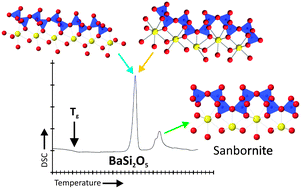The origin of the unusual DSC peaks of supercooled barium disilicate liquid†
Abstract
It is known that barium disilicate (BS2) glass exhibits two prominent exothermic peaks between the glass transition and melting temperatures in calorimetric experiments, however, their cause is not known. In this work, glass-ceramic samples were produced inside a differential scanning calorimeter (DSC) and then investigated ex situ with X-ray diffraction (XRD) and Raman spectroscopy. We found that the first exothermic peak results from multiphase crystallization although a signature of residual glass is still observed. H-BaSi2O5, and Ba3Si5O13 were directly identified after the first exothermic peak, however, both L-BaSi2O5 and an unknown phase(s) are also formed. Rietveld analysis indicates <1% Ba3Si5013 in the sample heat treated at 853 °C (the first exothermic peak maximum). Amorphous halos are observed in the XRD patterns of samples heated to temperatures until the second exothermic peak. Raman spectra suggest that the crystalline phases are somewhat distorted or contain defects. The second exothermic peak is actually a composite peak composed of two contributions. We interpret these shoulders as separate processes including crystallization of non-stoichiometric phases, crystallization of the residual glass, and the phase transition of monoclinic H-BaSi2O5 to orthorhombic L-BaSi2O5. After the second exothermic peak, the XRD and Raman spectra show that the samples have become L-BaSi2O5. These results clarify the relationships between thermal history and crystalline phase formation, which may be used to produce glass-ceramics with desirable properties.

- This article is part of the themed collection: Celebrating Latin American Talent in Chemistry


 Please wait while we load your content...
Please wait while we load your content...